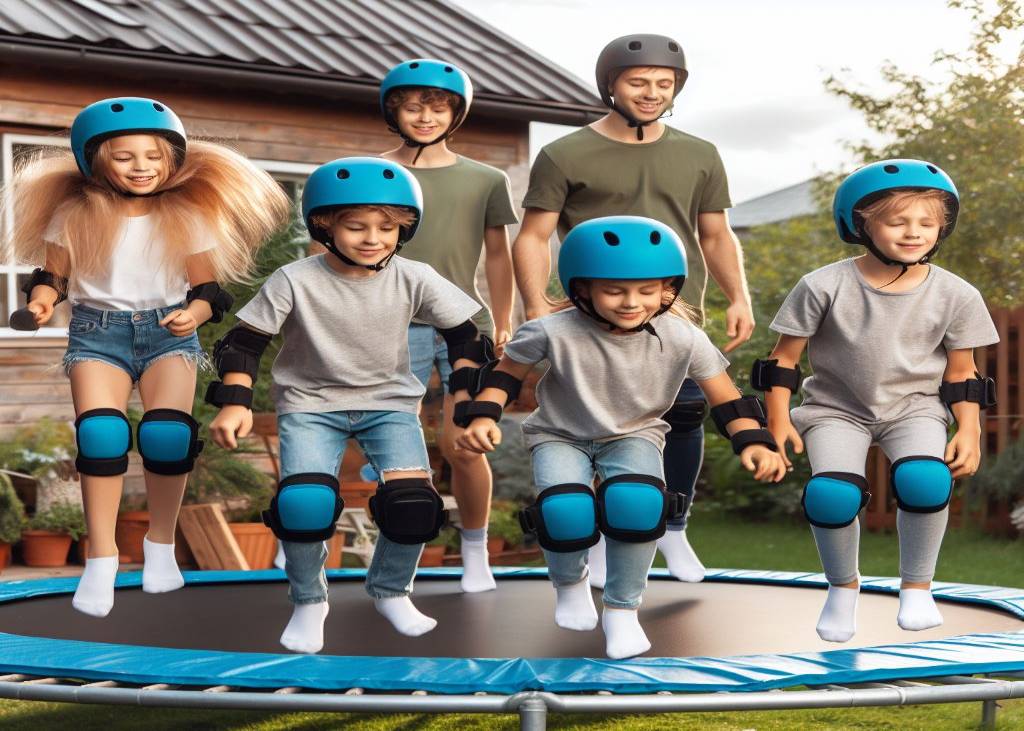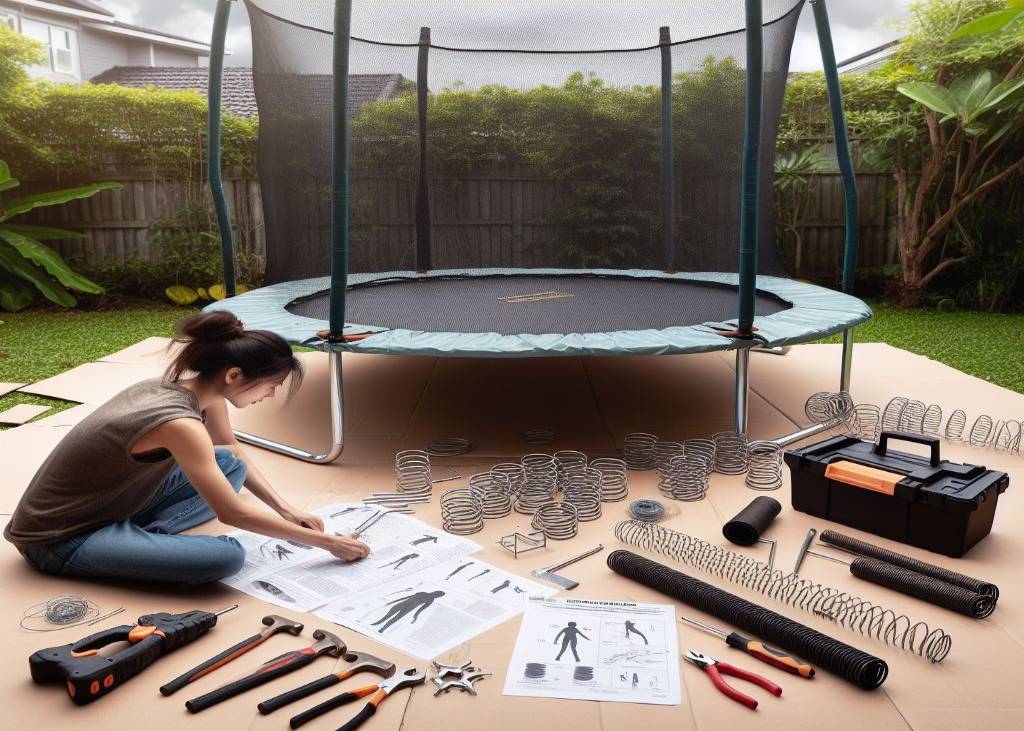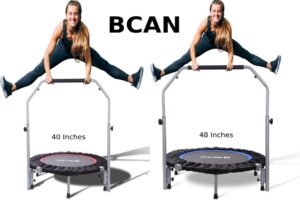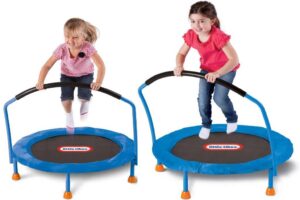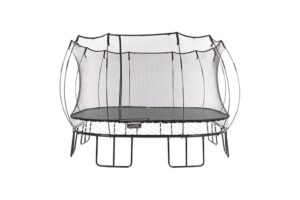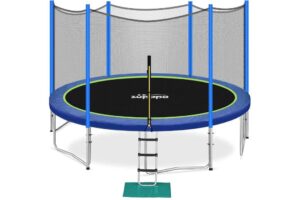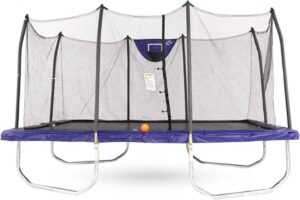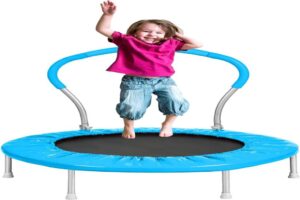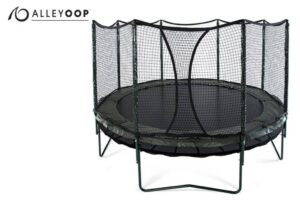Introduction
Trampolining, with its exhilarating leaps and bounces, has become a favorite pastime for families seeking outdoor fun and physical activity. The sheer joy of soaring through the air is undeniably infectious, creating memories that last a lifetime. However, amidst the thrill, it’s crucial to strike a balance between the excitement of trampolining and the necessity of trampoline safety precautions.
In this guide, we’ll delve into the realm of trampoline safety, exploring essential tips to ensure that every jump is filled with joy and free from unnecessary risks. Whether you’re a seasoned trampoline enthusiast or a newcomer to this bouncing world, understanding the importance of trampoline safety measures is paramount for a worry-free experience.
The Thrill of Trampolining
Picture the laughter of children, the sun shining overhead, and the rhythmic sound of springs as they propel you into the air. Trampolining offers a unique blend of exercise and entertainment, making it a go-to activity for families in search of outdoor recreation.
Balancing Joy and Caution
While the joy of trampolining is undeniable, it’s equally important to approach this activity with a sense of caution. The safety of those taking part, especially children, should be at the forefront of every trampoline adventure. This guide aims to equip you with the knowledge and tips needed to create an environment where joy and safety coexist harmoniously.
As we explore various aspects of trampoline safety, from understanding potential risks to implementing preventive measures, remember that a little preparation goes a long way in ensuring that every jump is a cause for celebration. Let’s embark on this journey together, discovering how to make trampolining a source of boundless joy without compromising on safety.
Understanding the Risks
Trampolining, while a source of endless joy, is not without its risks. According to the U.S. Consumer Product Safety Commission, trampoline-related injuries accounted for more than 200,000 emergency room visits in 2019. Before we dive into the world of trampoline safety measures, it’s crucial to familiarize ourselves with the potential dangers associated with this activity.
Common Trampoline-Related Injuries
Here, we’ll explore different types of injuries commonly associated with trampoline activities and emphasize the crucial importance of vigilance in averting them.
1. Sprains and Strains:
- One of the most common injuries on trampolines is sprains and strains, often resulting from awkward landings, twists, or sudden movements.
- Understanding proper jumping techniques and emphasizing controlled movements can help minimize the risk of these injuries.
2. Fractures and Dislocations:
- High-impact landings or collisions with other jumpers can lead to fractures and dislocations, particularly in the limbs.
- Adult supervision and the enforcement of trampoline safety rules, including limiting the number of users on the trampoline, play a crucial role in preventing these severe injuries.
3. Contusions and Bruises:
- Contusions and bruises may occur when jumpers collide with each other, the trampoline frame, or the springs.
- Proper padding on the trampoline, especially around the frame and springs, can reduce the severity of these injuries.
4. Head and Neck Injuries:
- Accidental falls or improper landings can lead to head and neck injuries, which can range from mild concussions to more severe trauma.
- Strict adherence to trampoline safety guidelines, including avoiding flips and somersaults without proper training and supervision, helps mitigate the risk of head and neck injuries.
5. Overexertion and Fatigue:
- Jumping for extended periods without breaks can result in overexertion and fatigue, increasing the risk of slips, falls, and other injuries.
- Setting time limits for trampoline use and encouraging users to take breaks are effective measures to prevent overexertion.
6. Impact with Hard Surfaces:
- Accidental falls from the trampoline or collisions with surrounding objects can lead to injuries caused by the impact with hard surfaces.
- Ensuring a safe jumping area, free from obstacles, and proper adult supervision are essential in minimizing the risk of such injuries.
Understanding the common injuries associated with trampolining allows users and supervisors to take proactive measures in preventing accidents.
Importance of Awareness and Education
Knowledge is a powerful tool in the pursuit of trampoline safety. Being aware of the potential risks allows us to take proactive steps to mitigate them. Whether you’re a parent supervising children on the trampoline or an individual enjoying a solo jump, understanding the inherent risks is crucial. This awareness lays the foundation for creating a safe trampolining environment.
Need for Adult Supervision
One of the key factors in minimizing trampoline-related injuries is adult supervision, especially when children are involved. Adults can help enforce trampoline safety rules, provide guidance on proper jumping techniques, and intervene if risky behavior is observed. The presence of a responsible adult adds an extra layer of protection, ensuring that the joy of trampolining is experienced in a controlled and safe manner.
As we move forward in this guide, keep these risks in mind. By acknowledging and understanding the potential dangers, we empower ourselves to implement effective trampoline safety measures that will allow us to enjoy the thrill of trampolining without compromising on well-being.
Trampoline Setup and Maintenance
Now that we’ve explored the risks associated with trampolining, let’s turn our attention to the crucial steps of setting up and maintaining a trampoline. Creating a secure foundation ensures a safe jumping environment for all enthusiasts.
Choosing a Safe Trampoline
Selecting the right trampoline is the first and crucial step towards ensuring a safe and enjoyable bouncing experience. Here, we’ll explore key considerations and tips for choosing a trampoline that prioritizes safety without compromising on fun.
1. Size and Space Considerations:
- Assess the available space in your yard before selecting a trampoline. Ensure there is sufficient room around the trampoline to prevent collisions with other objects or structures.
- Choose a trampoline size that accommodates the intended users. Larger trampolines provide more jumping space but may not be suitable for smaller yards.
2. Weight Capacity:
- Every trampoline comes with a specified weight limit. Take into account the total weight of all potential users to verify that the trampoline can adequately accommodate their weight.
- Opt for a trampoline with a higher weight capacity than the total weight of the users. This provides an additional safety margin and helps extend the trampoline’s lifespan.
3. Quality of Materials:
- Inspect the frame, springs, and jumping mat for durability. A sturdy frame made from galvanized steel enhances the trampoline’s overall stability.
- High-quality springs and a durable jumping mat contribute to a safer and more enjoyable bouncing experience. Look for UV-resistant materials to ensure longevity in various weather conditions.
4. Safety Features:
- Check for safety features such as safety nets, enclosures, and padding. A safety net or enclosure helps prevent accidental falls, while well-padded springs and frames reduce the risk of injuries during jumps.
- Ensure that the trampoline safety features meet industry standards and are designed specifically for the chosen model.
5. Reviews and Recommendations:
- Explore reviews from customers and seek advice from friends or online communities. Real-world experiences can provide valuable insights into the safety and performance of a particular trampoline brand or model.
- Look for trampolines that have received positive reviews for both safety and durability.
6. Warranty and Customer Support:
- A reliable warranty and good customer support indicate the manufacturer’s confidence in their product. Examine the warranty particulars to comprehend the extent and duration of coverage.
- Inquire about customer support options, especially if you encounter any issues during assembly or use.
Choosing a safe trampoline involves a combination of careful consideration and thorough research. By prioritizing factors such as size, weight capacity, quality, safety features, and customer feedback, you can confidently select a trampoline that provides a secure foundation for countless hours of bouncing fun.
Proper Assembly and Installation
The journey to a safe and enjoyable trampoline experience begins with the proper assembly and installation of the equipment.
Here, we’ll explore the key steps and considerations to ensure that your trampoline is securely set up, providing a stable foundation for countless moments of bouncing fun.
1. Follow Manufacturer’s Instructions:
- Every trampoline comes with a set of manufacturer’s instructions. Begin the assembly process by carefully reading and following these guidelines. Skipping steps or overlooking details can compromise the trampoline’s stability.
2. Choose a Suitable Location:
- Selecting an appropriate location is paramount. Ensure the chosen area is flat, level, and free from potential hazards such as rocks or tree roots. The trampoline should have ample clearance from walls, fences, and overhead obstructions.
3. Inspect Components Before Assembly:
- Before assembling the trampoline, inspect all components for any damage or defects. This includes checking the frame, springs, jumping mat, and safety features. Address any issues promptly, and if necessary, contact the manufacturer for replacement parts.
4. Secure the Frame:
- Begin the assembly by connecting and securing the frame according to the manufacturer’s instructions. Ensure that all frame components are tightly fastened to provide stability during use.
5. Attach Springs and Jumping Mat:
- Properly attach the springs to the frame and connect them to the jumping mat. Follow the recommended pattern and tension guidelines provided in the instructions. This step is critical for creating an even and responsive bouncing surface.
6. Install Safety Enclosures and Padding:
- If your trampoline includes safety enclosures and padding, install them according to the manufacturer’s guidelines. Safety enclosures help prevent accidental falls, while padding over springs and the frame minimizes the risk of injuries during jumps.
7. Regularly Check and Tighten Bolts:
- Once the trampoline is assembled, routinely check and tighten all bolts and connections. Regular maintenance ensures that the trampoline remains stable and secure over time.
8. Consider Professional Assembly:
- If you’re unsure about the assembly process or want to guarantee optimal setup, consider hiring professionals for trampoline assembly. Many manufacturers or local service providers offer this service, ensuring that the trampoline is assembled correctly.
Proper assembly and installation lay the groundwork for a safe trampolining experience. By diligently following guidelines, inspecting components, and maintaining the equipment, you contribute to a secure environment where every bounce is a leap of joy.
Regular Maintenance for a Secure Surface
Ensuring a safe and enjoyable trampoline experience extends beyond the initial setup – regular maintenance is key to preserving the integrity and security of the bouncing surface. Here, we’ll explore essential maintenance practices that contribute to a secure and durable trampoline.
1. Routine Visual Inspections:
- Conduct regular visual inspections of the entire trampoline, focusing on the frame, springs, and jumping mat. Look for signs of wear, rust, or any visible damage. Promptly address any issues to prevent potential hazards.
2. Tightening Bolts and Connections:
- Trampolines experience natural wear and tear over time. Regularly check and tighten all bolts, screws, and connections. Loose components can compromise the stability, leading to trampoline safety concerns.
3. Assessing the Jumping Mat:
- Examine the jumping mat for any signs of fraying, stretching, or holes. A damaged jumping mat can affect the trampoline’s bounce and pose a risk to users. Replace the mat if necessary, following the manufacturer’s guidelines.
4. Checking Springs for Tension:
- Verify the tension of the springs, ensuring they are evenly distributed. Loose or damaged springs can impact the trampoline’s performance and safety. Replace any springs that show signs of wear or damage.
5. Inspecting Safety Enclosures:
- If your trampoline features safety enclosures, inspect them regularly. Ensure that the netting is intact and securely attached to the frame. Any tears or gaps should be promptly repaired to prevent accidental falls.
6. Padding Over Springs and Frame:
- Check the padding covering the springs and frame for wear and tear. This padding serves as a crucial trampoline safety measure, preventing users from coming into direct contact with the springs. Replace damaged or worn-out padding promptly.
7. Addressing Weather-Related Issues:
- Exposure to the elements can impact the trampoline’s condition. Remove debris, such as leaves or branches, from the jumping surface. Additionally, if the trampoline is not in use for an extended period, consider covering it to protect it from the elements.
8. Storage During Adverse Weather:
- In cases of severe weather conditions, such as storms or heavy snowfall, consider disassembling and storing the trampoline. This extra precaution prevents potential damage and ensures a longer lifespan for the equipment.
By incorporating regular maintenance into your trampoline care routine, you not only enhance its safety but also extend its usability.
Trampoline Safety Accessories
While proper setup and maintenance lay the groundwork for trampoline safety, the addition of safety accessories plays a pivotal role in creating a secure environment for jumpers of all ages.
Role of Enclosures, Padding, and Anchor Kits
Here, we’ll explore the various trampoline safety accessories that can significantly enhance the overall safety of your trampolining experience.
1. Enclosures: Creating a Protective Barrier:
- Safety enclosures, often in the form of nets surrounding the trampoline, act as a crucial protective barrier. They help prevent accidental falls, keeping jumpers within the designated bouncing area.
- Choose enclosures designed for your specific model, ensuring they meet trampoline safety standards and feature fine mesh to prevent entanglement.
2. Padding: Cushioning Impact Points:
- Trampoline padding, covering the springs and frame, serves as a vital cushion against potential impact. It minimizes the risk of injuries caused by contact with the trampoline’s hard surfaces during jumps.
- Regularly inspect the padding for wear and tear, and promptly replace any damaged or worn-out sections to maintain its effectiveness.
3. Anchor Kits: Securing Stability in Windy Conditions:
- In windy conditions, a trampoline can become unstable, posing a risk of tipping over. Anchor kits, which secure the trampoline to the ground, play a crucial role in preventing movement during adverse weather conditions.
- Ensure that the anchor kit is compatible with your trampoline and follow the manufacturer’s guidelines for proper installation.
Selecting and Installing Safety Nets
Safety nets are an integral component of trampoline accessories, providing an additional layer of protection to ensure a secure and enjoyable bouncing experience. Here, we’ll explore the importance of safety nets, guidelines for selecting the right one, and proper installation practices.
1. Choosing Safety Nets:
- Compatibility with Trampoline Model: When selecting a safety net, ensure that it is designed for your specific trampoline model. Different trampolines may have varying dimensions and attachment mechanisms, so choosing a net that aligns with your equipment is crucial for a proper fit.
- Meeting Safety Standards: Opt for safety nets that meet industry safety standards. This ensures that the net is designed and tested to provide effective protection during trampolining activities.
- Fine Mesh Design: Look for safety nets with a fine mesh design. This not only enhances the net’s durability but also prevents fingers or limbs from getting entangled, adding an extra layer of trampoline safety for users.
2. Proper Installation Guidelines:
- Follow Manufacturer’s Instructions: The proper installation of a safety net begins with carefully reading and following the manufacturer’s instructions. Each trampoline model may have specific requirements, and adherence to these guidelines is crucial for optimal performance.
- Secure Attachment Points: Ensure that the safety net is securely attached to the trampoline frame at multiple points. A robust attachment prevents gaps or sagging, maintaining the integrity of the protective barrier.
- Regular Inspection and Maintenance: Once installed, routinely inspect the safety net for any signs of wear or damage. Check the attachment points, mesh integrity, and the overall condition of the net. Promptly address any issues to maintain its effectiveness.
3. Checking for Compatibility:
- Verify Compatibility: Before purchasing a safety net, verify that it is compatible with your trampoline’s size and shape. Safety nets are designed to match specific dimensions, and choosing the right fit is essential for optimal performance.
- Consider Enclosure Pole Design: Some safety nets use enclosure poles to provide structural support. Confirm that the design of these poles aligns with your trampoline model and that they are securely attached.
4. Importance of Safety Nets in Injury Prevention:
- Safety nets are instrumental in preventing accidental falls from the trampoline. Their presence creates a secure enclosure, significantly reducing the risk of users landing outside the designated bouncing area.
- By investing in a high-quality safety net and ensuring its proper installation, you enhance the overall safety of trampoline activities.
Safety accessories are not just optional add-ons; they are integral components that significantly contribute to injury prevention. By investing in and properly utilizing enclosures, padding, and anchor kits, you create a trampoline environment that minimizes the risk of accidents and enhances the overall safety of the jumping experience.
As we continue our exploration of trampoline safety, we will delve into safe jumping practices, emphasizing techniques and guidelines to further reduce the likelihood of injuries during trampolining activities.
Safe Jumping Practices
Now that we’ve established a secure trampoline setup with the right accessories, it’s time to focus on the heart of the trampolining experience: safe jumping practices. By understanding and implementing proper techniques, jumpers can significantly reduce the risk of injuries and ensure a joyful bouncing adventure.
Guidelines for Proper Jumping Techniques
- Centered Bouncing: Encourage jumpers to stay centered on the trampoline, avoiding the edges where accidents are more likely to occur. This helps maintain balance and reduces the risk of falling off.
- Controlled Movements: Emphasize controlled and purposeful movements while jumping. Discourage erratic or uncontrolled bouncing, as this can lead to collisions and awkward landings.
- One Jumper at a Time: To avoid collisions and ensure a safer jumping experience, limit the trampoline to one person at a time, especially for smaller-sized trampolines. This reduces the risk of accidents caused by multiple users sharing the space.
Age-Appropriate Activities
- Supervise Younger Jumpers: For younger children, active supervision is crucial. Ensure they understand and follow the trampoline safety guidelines, and discourage activities beyond their skill level.
- Limit Stunts and Flips: While flips and stunts can be enticing, they also pose a higher risk of injury. Encourage jumpers to perform only age-appropriate and skill-level-appropriate maneuvers.
Controlled and Supervised Bouncing
- Adult Presence: Whenever possible, have a responsible adult present to supervise trampoline activities. Their oversight can prevent risky behaviors and address any trampoline safety concerns promptly.
- Set Time Limits: Establishing time limits for trampoline use helps prevent overexertion and fatigue, reducing the likelihood of accidents caused by tiredness.
By instilling these safe jumping practices, trampoline enthusiasts can enjoy the thrill of bouncing while minimizing the risk of injuries. Next, we’ll explore considerations for trampoline use during various weather conditions, ensuring that trampoline safety measures extend beyond sunny days for a well-rounded and secure trampolining experience.
Weather Considerations
Trampoline enthusiasts often find themselves eager to jump regardless of the weather. However, understanding the impact of different weather conditions on trampoline safety is crucial for maintaining a secure and enjoyable experience. Here, we’ll explore considerations for trampoline use during various weather conditions.
Impact of Weather Conditions on Safety
- Wind: Windy conditions can significantly affect the stability of a trampoline. High winds may cause the trampoline to tip over or move unexpectedly, posing a risk to jumpers. It’s essential to avoid trampolining during strong winds.
- Rain: Wet surfaces can make the trampoline slippery, increasing the likelihood of slips and falls. Additionally, rainwater can accumulate on the trampoline surface, affecting the quality of the bounce. Jumping on a wet trampoline is discouraged for safety reasons.
- Snow and Ice: Trampolining on a snow- or ice-covered surface is not recommended. The added weight and slippery conditions can compromise the trampoline’s structure and create hazardous situations for jumpers.
Guidelines for Windy or Rainy Weather
- Check the Weather Forecast: Before heading out for a trampoline session, always check the weather forecast. If windy or rainy conditions are predicted, it’s best to postpone trampolining activities.
- Secure the Trampoline: In windy conditions, secure the trampoline with anchor kits to prevent it from tipping over. Additionally, consider disassembling and storing the trampoline during severe weather to ensure its safety and longevity.
- Avoid Jumping on Wet Surfaces: If it has rained recently, allow the trampoline surface to dry completely before use. Wet surfaces can compromise traction, leading to slips and falls.
By being mindful of weather conditions and adhering to trampoline safety guidelines, trampoline enthusiasts can enjoy their favorite activity while minimizing the associated risks. Next, we’ll delve into the importance of establishing rules and guidelines for trampoline use, fostering a safe and controlled environment for all participants.
Establishing Rules and Guidelines
As we embark on the final stretch of our exploration into trampoline safety, it’s crucial to discuss the significance of establishing rules and guidelines. By setting clear expectations for trampoline use, you create a structured and secure environment that enhances the overall safety of this exhilarating activity.
Necessity of Ground Rules for Trampoline Use
- Safety as a Priority: Make it clear that safety is the top priority when using the trampoline. Emphasize the importance of following established rules to prevent accidents and injuries.
- Age-Appropriate Guidelines: Tailor rules to the age and skill level of the participants. Younger jumpers may have different capabilities and limitations compared to older, more experienced users.
- Prohibition of Risky Behavior: Clearly outline activities that are off-limits, such as somersaults or flips, unless the jumper has received proper training and supervision. Discourage behaviors that may compromise safety.
Examples of Trampoline Safety Rules
- One Jumper at a Time: To minimize the risk of collisions and accidents, enforce a rule allowing only one person on the trampoline at a time.
- No Shoes Allowed: Prohibit the use of shoes on the trampoline to prevent damage to the jumping surface and reduce the risk of slipping.
- Supervision Requirement: Specify that trampoline use should always be supervised, especially for younger participants. Designate a responsible adult to oversee activities and address any safety concerns.
Open Communication Between Parents and Children
- Encourage Communication: Foster an open dialogue between parents and children regarding trampoline safety. Encourage children to voice any concerns or report issues with the trampoline promptly.
- Regular Safety Checks: Teach children the importance of routine trampoline safety checks before using. This includes inspecting the equipment and ensuring that the trampoline safety accessories are in place and functioning correctly.
By establishing and enforcing rules and guidelines, you not only create a safer trampolining environment but also instill a sense of responsibility and awareness among participants. As we conclude our journey into trampoline safety, let’s recap key takeaways and reinforce the importance of maintaining a balance between joy and caution in every bounce.
Conclusion
Trampolining is a source of boundless joy and physical activity, but it’s crucial to approach it with a sense of responsibility. By prioritizing trampoline safety through awareness, proper setup, and adherence to guidelines, we can ensure that every jump is a cause for celebration rather than concern.
As trampoline enthusiasts, it’s our collective responsibility to foster a culture of safety within our trampolining communities. Encourage open communication, regular safety checks, and the dissemination of safety knowledge to create an environment where joy and safety coexist harmoniously.
In every bounce, let the thrill of trampolining be complemented by a commitment to safety. By incorporating the tips and guidelines discussed in this guide, you can confidently embark on your trampoline adventures, knowing that you’ve taken the necessary steps to minimize risks and make each jump a joyful and secure experience.
Thank you for joining us on this journey through the world of trampoline safety. Here’s to countless hours of safe and joyous bouncing!
Related posts:
- Trampoline Disassembly Guide: Unlocking the Secrets to Safe Dismantling
- Trampoline Maintenance Essentials: Energize Your Jumping Fun
- Trampoline Cleaning Power Guide: Optimizing Safety and Longevity
- Trampoline Hole Repair Guide: Masterful Fixes for Unleashing Bouncing Power!
- The Ultimate Trampoline Measurements Guide: Elevate Your Bouncing Experience
